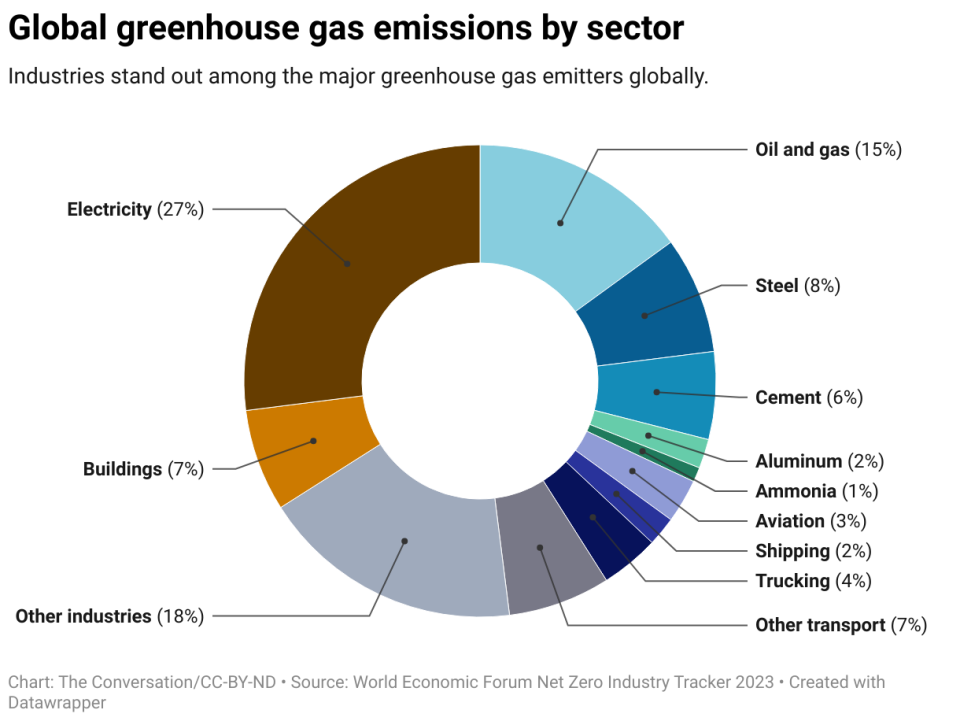As government leaders and climate negotiators gather in Dubai for the United Nations climate conference COP28, a huge challenge looms over the proceedings: decarbonizing the global industrial sector.
The industry has accounted for more than 30% of total greenhouse gas emissions in recent years. It is the largest emitting sector if its use of electricity and heat generation is taken into account.
For countries to meet their goals of reducing greenhouse gas emissions, it is imperative to stop emissions from carbon-intensive industries such as steel, cement and chemicals.

There are promising technologies and innovations that can drive decarbonization in the industry: green hydrogen fuel made from clean electricity and water, energy efficiency measures in supply chains, and carbon capture, utilization and storage, to name a few.
However, these solutions have not yet been implemented at the speed and scale necessary to curb global warming.
Global industrial emissions will need to fall 25% by 2030 for the world to be on track to achieve net-zero emissions by 2050, a goal espoused by many of the world’s largest economies. This is an extremely steep decline of 3% annually and will require a massive mobilization of money, technology and political will.
The positive news is that many countries are taking steps in the right direction. The U.S. Inflation Reduction Act, signed in 2022, includes approximately $80 billion per year for climate initiatives between 2022 and 2027, with provisions to spur the deployment of clean technologies and incentivize emissions reductions in all industrial sectors.
But the efforts of developed countries, while commendable, are insufficient to drive global decarbonization at the pace necessary to keep global warming under control. Developing countries face enormous barriers to adopting low-carbon technologies, from lack of infrastructure to insufficient skills and capacity.
In a recent article published in the journal Energy Research & Social Science, based on a series of in-depth analyzes on specific industries, we established a comprehensive roadmap to decarbonize industry worldwide. These are some of the key points.
Expand finances
First, a radical increase in financing for industrial decarbonization in the developing world is needed. Annual investments will have to increase at least seven-fold by 2030 for the world to be on track to achieve net-zero emissions by mid-century.
Grants, loans, risk guarantees and equity investments provided through public and private institutions can help mobilize both public and private investments to achieve that goal. That financing can begin with developed countries meeting and exceeding their commitment to provide $100 billion in climate finance to developing countries each year. Developed countries bear most of the responsibility for past emissions that have driven climate change.
More technology transfer
Decarbonization will advance faster if developed countries accelerate their technology transfer to the Global South. That is, ensuring that developing economies receive the necessary advanced technologies and are included in global value chains.
With the majority of industrial emissions expected to come from emerging economies by mid-century, disseminating knowledge and experience will be critical. Partnerships between countries and companies can facilitate demonstration projects for new technologies such as green hydrogen and carbon capture in developing countries.
Improving job training
The transition to net zero emissions will also require a massive workforce with new skills, so investing in human capital and training is essential.
Businesses and governments can collaborate to develop curricula and learning programs focused on green technologies. Building this pipeline of talent to build and install renewable energy, such as solar panels and appliances such as heat pumps, must begin now. While demand for these technologies is high, one of the key constraints to their rapid growth is workforce development, across geographies and technology types.
Ensure a just transition
Another priority is a just transition for communities that have relied on fossil fuels for generations. As industries transform, some jobs will be lost and new ones created. Ensuring that economic and environmental benefits are spread across economies will require strong government and industry programs to assist displaced workers.
Establish a global treaty
Finally, a new global treaty to coordinate industrial decarbonization will likely be needed to move quickly enough. The treaty could set standards, incentivize policy coordination and prevent unfair competition as countries move to net-zero industries.
“Climate clubs” (groups of developed and developing countries working together to reduce emissions from specific industrial sectors) can also foster progress and technology sharing as they jointly implement decarbonization goals.
In our view, the path to net-zero emissions industries will be challenging but not impossible.
With smart policies, investments in technology and human capital, and bold leadership from countries in the Global North and South, we believe the decarbonization of heavy industry could become the next big climate and economic development success story.
This article is republished from The Conversation, an independent, nonprofit news organization bringing you data and analysis to help you understand our complex world.
It was written by: Morgan Bazilian, Colorado School of Mines; Benjamin K. Sovacool, university of sussexand Steven Griffiths, Caliph University.
Read more:
Morgan Bazilian is a member of the Irish Climate Council
Benjamin K. Sovacool and Steven Griffiths do not work for, consult with, own shares in, or receive funding from any company or organization that would benefit from this article, and have disclosed no relevant affiliations beyond their academic appointment.